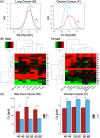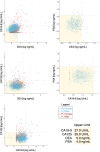Elemental analysis by Metallobalance provides a complementary support layer over existing blood biochemistry panel-based cancer risk assessment
- PMID: 34707935
- PMCID: PMC8496461
- DOI: 10.7717/peerj.12247
Elemental analysis by Metallobalance provides a complementary support layer over existing blood biochemistry panel-based cancer risk assessment
Abstract
Despite the benefit of early cancer screening, Japan has one of the lowest cancer screening rates among developed countries, possibly due to there being a lack of "a good test" that can provide sufficient levels of test sensitivity and accuracy without a large price tag. As a number of essential and trace elements have been intimately connected to the oncogenesis of cancer, Metallobalance, a recent development in elemental analysis utilizing the technique of inductively coupled plasma mass spectrometry has been developed and tested as a robust method for arrayed cancer risk screening. We have conducted case-control epidemiological studies in the prefecture of Chiba, in the Greater Tokyo Area, and sought to determine both Metallobalance screening's effectiveness for predicting pan-cancer outcomes, and whether the method is capable enough to replace the more conventional antigen-based testing methods. Results suggest that MB screening provides some means of classification potential among cancer and non-cancer cases, and may work well as a complementary method to traditional antigen-based tumor marker testing, even in situations where tumor markers alone cannot discernibly identify cancer from non-cancer cases.
Keywords: Cancer biology; Chemical biology; Epidemiology; Mass spectrometry; Preventative medicine.
©2021 Kusakabe et al.
Conflict of interest statement
The authors declare that there are no competing interests.
Figures






Similar articles
-
The synergy of elemental and biomolecular mass spectrometry: new analytical strategies in life sciences.Chem Soc Rev. 2009 Jul;38(7):1969-83. doi: 10.1039/b618635c. Epub 2009 Apr 16. Chem Soc Rev. 2009. PMID: 19551177 Review.
-
Nanotechnology: an evidence-based analysis.Ont Health Technol Assess Ser. 2006;6(19):1-43. Epub 2006 Nov 1. Ont Health Technol Assess Ser. 2006. PMID: 23074489 Free PMC article.
-
Beyond the black stump: rapid reviews of health research issues affecting regional, rural and remote Australia.Med J Aust. 2020 Dec;213 Suppl 11:S3-S32.e1. doi: 10.5694/mja2.50881. Med J Aust. 2020. PMID: 33314144
-
Candida and candidaemia. Susceptibility and epidemiology.Dan Med J. 2013 Nov;60(11):B4698. Dan Med J. 2013. PMID: 24192246 Review.
-
Trace element profiling using inductively coupled plasma mass spectrometry and its application in an osteoarthritis study.Anal Chem. 2009 May 1;81(9):3683-92. doi: 10.1021/ac900311q. Anal Chem. 2009. PMID: 19331394
Cited by
-
Inductively Coupled Plasma Mass Spectrometry Performance for the Measurement of Key Serum Minerals: A Comparative Study With Standard Quantification Methods.J Clin Lab Anal. 2025 Jan;39(2):e25140. doi: 10.1002/jcla.25140. Epub 2024 Dec 23. J Clin Lab Anal. 2025. PMID: 39716823 Free PMC article.
-
A new clustering model based on the seminal plasma/serum ratios of multiple trace element concentrations in male patients with subfertility.Reprod Med Biol. 2024 May 28;23(1):e12584. doi: 10.1002/rmb2.12584. eCollection 2024 Jan-Dec. Reprod Med Biol. 2024. PMID: 38807752 Free PMC article.
-
Distinct Clusters of Testosterone Levels, Symptoms, and Serum Trace Elements in Young Men: A Cross-Sectional Analysis.Nutrients. 2025 Feb 28;17(5):867. doi: 10.3390/nu17050867. Nutrients. 2025. PMID: 40077734 Free PMC article.
-
Shifting the Cancer Screening Paradigm: The Rising Potential of Blood-Based Multi-Cancer Early Detection Tests.Cells. 2023 Mar 18;12(6):935. doi: 10.3390/cells12060935. Cells. 2023. PMID: 36980276 Free PMC article. Review.
References
-
- Brunnbauer L, Mayr M, Larisegger S, Nelhiebel M, Pagnin L, Wiesinger R, Schreiner M, Limbeck A. Combined LA-ICP-MS/LIBS: powerful analytical tools for the investigation of polymer alteration after treatment under corrosive conditions. Scientific Reports. 2020;10:12513. doi: 10.1038/s41598-020-69210-9. - DOI - PMC - PubMed
-
- Bast Jr RC, Klug TL, St.John E, Jenison E, Niloff JM, Lazarus E, Berkowitz RS, Leavitt T, Griffiths CT, Parker L, Zurawski Jr VR, Knapp RC. A radioimmunoassay using a monoclonal antibody to monitor the course of epithelial ovarian cancer. New England Journal of Medicine. 1983;309(15):883–887. doi: 10.1056/NEJM198310133091503. - DOI - PubMed
-
- Editorial Board of the Cancer Statistics in Japan. Cancer Statistics in Japan 1st ed. Tokyo, Japan: FPCR; 2021. ISSN: 2433-3212. 2021. https://ganjoho.jp/public/qa_links/report/statistics/2021_en.html. [3 September 2021]. https://ganjoho.jp/public/qa_links/report/statistics/2021_en.html
LinkOut - more resources
Full Text Sources
Research Materials
Miscellaneous

